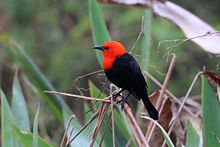| Scarlet-headed blackbird | |
|---|---|

| |
| in the Pantanal, Brazil | |
| Conservation status | |
 Least Concern (IUCN 3.1) | |
| Scientific classification | |
| Domain: | Eukaryota |
| Kingdom: | Animalia |
| Phylum: | Chordata |
| Class: | Aves |
| Order: | Passeriformes |
| Family: | Icteridae |
| Genus: | Amblyramphus Leach, 1814 |
| Species: | A. holosericeus |
| Binomial name | |
| Amblyramphus holosericeus (Scopoli, 1786) | |

| |
The scarlet-headed blackbird (Amblyramphus holosericeus) is an icterid found in the South American wetlands.
Description
This species is about 24 cm long. The bill is oddly shaped: long, slender, and very sharp, looking almost upturned. Adults of both sexes are described by their name. Juveniles have entirely black plumage; orange-red feathers first appear on their breast and throat, later spreading to the neck, head, and thighs. The song is given as "loud, clear, and melodic, a ringing 'cleer-cleer-clur, clulululu'." Calls are simpler but have a similar quality.
Scarlet-headed blackbirds occur in pairs in large reed beds in Argentina, Paraguay, Uruguay and southern Brazil; Bolivia has an isolated population living at an altitudes of about 600 m. They often perch conspicuously on top of stems. They are uncommon, particularly away from the coast.
They eat mainly fruit, supplementing it with seeds and invertebrates, especially insects. They use their bill as a hammer to open food items.
Scarlet-headed blackbirds are monogamous, and territories are grouped together. The nest is an open cup placed in the crotch of a shrub or woven into vegetation, in which they lay two eggs.
Gallery
References
- BirdLife International (2018). "Amblyramphus holosericeus". IUCN Red List of Threatened Species. 2018: e.T22724265A132029107. doi:10.2305/IUCN.UK.2018-2.RLTS.T22724265A132029107.en. Retrieved 12 November 2021.
- ^ Ridgely, Robert S.; Tudor, Guy (1989). The Birds of South America: The Oscine Passerines. University of Texas Press. p. 345. ISBN 0-292-70756-8. Retrieved 2007-02-19.
- ^ "Scarlet-headed blackbird". Meet the Animals. Toronto Zoo. Archived from the original on 2006-11-11. Retrieved 2007-02-19.
External links
 Media related to Amblyramphus holosericeus at Wikimedia Commons
Media related to Amblyramphus holosericeus at Wikimedia Commons Data related to Amblyramphus holosericeus at Wikispecies
Data related to Amblyramphus holosericeus at Wikispecies- Scarlet-headed blackbird videos - Internet Bird Collection
- Stamps (for Argentina, Uruguay) with range map
- Scarlet-headed blackbird photo gallery - VIREO
- Scarlet-headed blackbird photos (Brazil)
- Scarlet-headed blackbird - Neotropical Birds
| Taxon identifiers | |
|---|---|
| Amblyramphus holosericeus |
|
This Icteridae-related article is a stub. You can help Misplaced Pages by expanding it. |




